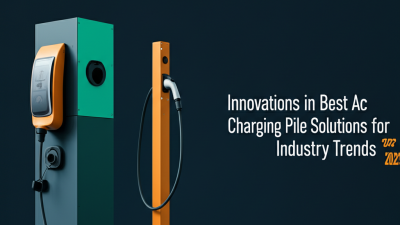As the electric vehicle (EV) market continues to grow, the demand for efficient and advanced Ac Charging Pile solutions is becoming increasingly critical. According to a report by the International Energy Agency, global electric car sales are expected to reach around 145 million by 2030, underscoring the necessity for robust charging infrastructure. Innovations in Ac Charging Pile technology are emerging to meet this demand, focusing on enhanced charging speeds, user convenience, and integration with renewable energy sources. By 2025, industry trends suggest that smart charging strategies and improved interoperability will be essential in the development of these charging solutions. This blog will explore the latest innovations shaping the Ac Charging Pile landscape and examine the reasons behind these trends, highlighting their significance for the EV ecosystem and sustainability goals.

As we look towards 2025, a range of emerging technologies is poised to dramatically reshape AC charging pile solutions. With the increasing emphasis on sustainable energy, advancements in smart grid technology will play a crucial role in optimizing electric vehicle (EV) charging infrastructure. By leveraging real-time data analytics and IoT (Internet of Things) connectivity, charging piles will not only efficiently manage energy distribution but also enhance user experience through dynamic load balancing and predictive maintenance. This integration will ensure that charging stations operate seamlessly, matching demand fluctuations while minimizing energy wastage.
In addition, the development of rapid charging technologies is expected to enable shorter charging times without compromising vehicle battery integrity. Innovations in materials science, such as the use of high-conductivity superconductors, will further increase the efficiency of AC charging piles. Coupled with advancements in semiconductor technology, this could lead to the creation of compact, high-power charging solutions that are more cost-effective and scalable for widespread deployment. As these technologies mature, they will pave the way for a robust charging network that not only meets the rising demand for EVs but also aligns with global sustainability goals.
The electric vehicle (EV) charging infrastructure is poised for significant transformation by 2025, driven by emerging trends and increasing demand for sustainable transport solutions. A recent report indicates that the market for EV charger rentals is experiencing a pivotal shift, highlighting the growing necessity for accessible charging options as EV adoption surges. This trend is not only enhancing convenience but also aligning with global sustainability goals, making EV charging more appealing to both consumers and businesses.
Additionally, the engineering polymers market within the EV charging infrastructure is projected to see substantial growth, as companies aim to optimize materials for improved durability and performance. A comprehensive analysis reveals that various regions are ripe with opportunities for manufacturers, driven by advances in technology and changing consumer preferences. These developments signal a broader shift in the industry, where innovative materials and enhanced infrastructure play critical roles in shaping the future of electric vehicle charging solutions. As we approach 2025, the interplay between these trends will be pivotal in advancing not only EV technology but also the overall landscape of transportation.
The rise of electric vehicles (EVs) necessitates a shift towards smarter charging solutions, fundamentally reshaping how we approach charging station infrastructure. As we look towards 2025, the integration of advanced technologies in AC charging piles will play a pivotal role in enhancing charging efficiency and user experience. Smart charging solutions leverage real-time data and connectivity, allowing users to monitor charging status through mobile apps, schedule charging times to take advantage of lower electricity rates, and even receive notifications when their vehicle is fully charged.
Innovative features such as dynamic load management and user-specific charging plans will optimize energy consumption while minimizing costs. Additionally, these solutions will incorporate machine learning algorithms that predict peak usage times, adjusting availability accordingly, which leads to reduced wait times for users. Moreover, with seamless payment integration, customers can enjoy a more streamlined experience, eliminating the hassle of traditional payment methods.
As these smart solutions become commonplace, they will not only boost user satisfaction but also contribute to a more sustainable energy ecosystem, paving the way for a greener future in transportation.
As the demand for electric vehicles escalates, the need for sustainable and efficient AC charging pile solutions becomes increasingly crucial. Innovations in AC charging technology are paving the way for greener infrastructure, emphasizing renewable energy integration. By harnessing solar and wind power, new charging systems can operate with minimal environmental impact, reducing reliance on fossil fuels and promoting a cleaner energy grid. These advancements reflect a shift towards eco-friendly practices, aligning with global sustainability goals.
Furthermore, the development of smart charging piles contributes significantly to energy management. Equipped with capabilities for grid interaction, these charging stations can optimize energy distribution according to demand, ensuring that the charging process is not only efficient but also environmentally conscious. The incorporation of advanced materials and designs, such as lightweight composites and modular systems, further enhances the sustainability profile of AC charging stations. As industry players invest in research and development, the future of AC charging infrastructure looks promising, paving the way for a more sustainable automotive landscape.
| Dimension | Current Status (2023) | Predicted Trends (2025) | Sustainability Measures |
|---|---|---|---|
| Charging Speed | 7.2 kW to 22 kW | Up to 50 kW | Integration of renewable energy sources |
| Material Usage | Conventional plastics and metals | Bio-based and recycled materials | Recycling initiatives for old units |
| User Interface | Basic LCD displays | Interactive apps and voice control | User education on sustainable options |
| Installation Locations | Commercial and residential areas | Widespread adoption in public and rural areas | Community-oriented charging stations |
| Government Policy | Limited incentives | Increased subsidies and regulations | Green certification programs |
As we approach 2025, the landscape of electric vehicle charging solutions is set to undergo significant transformations, particularly in response to evolving regulatory standards. The introduction of new compliance requirements will be pivotal for industries relying on AC charging pile solutions. Stakeholders must not only understand these impending regulations but also align their strategies to ensure adherence while enhancing operational efficiency. This involves navigating complex frameworks that not only encompass technical specifications but also data management, solvency, and environmental considerations, given their relevance across various sectors, including finance and technology.
Moreover, as seen in different industries, such as the banking sector, there's a cautious optimism amid regulatory shifts, indicated by banks adapting to the digital asset boom despite volatility. Similar adaptability will be essential for AC charging infrastructure providers as they prepare for stringent guidelines on safety, efficiency, and sustainability. By focusing on proactive compliance and embracing innovation, the industry can turn potential challenges into opportunities for growth and leadership in the evolving market of electric mobility.
